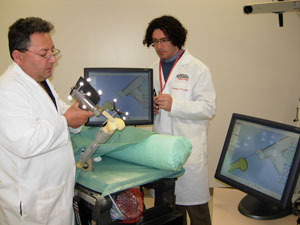 |
Hani Haider, Ph.D., (left), and Andres Barrera, demonstrate the Computer Aided Orthopedic Surgery Suite, which is showing great promise in enhancing the accuracy of implant placement. Dr. Haider is an associate professor in the UNMC Department of Orthopaedic Surgery & Rehabilitation, and director of its Biomechanics Laboratory at the Scott Technology Center in Omaha. Barrera is a research associate in the lab. |
Perhaps no area of health care will be affected more than orthopaedic surgery as Baby Boomers age and their knees and hips start to wear out.
Compounding a continuing rise in joint replacement surgeries is the number of surgeries that need to be redone.
One reason for all the repeated surgeries is about 80 percent of joint replacement procedures performed in the United States are done by surgeons who don’t specialize in replacing joints.
A UNMC team developing a computerized surgical system may be able to help reduce the number of re-do surgeries by improving surgical precision, which not only would increase the life of artificial joints, but would potentially reduce patient recovery time.
The UNMC team includes surgeons Kevin Garvin, M.D., professor and chairman of the UNMC Department of Orthopaedic Surgery and Rehabilitation and engineers led by Hani Haider, Ph.D., associate professor in the department of orthopaedic surgery and rehabilitation and director of its biomechanics laboratory at the Scott Technology Center in Omaha.
They are developing a system that tracks the bone and the surgeon’s hand-held instruments to guide them in knee replacement. The system will be on display next week at the Biotechnology Industry Organization (BIO) Convention in Boston.
In essence, the surgery is “tailor made” for the patient. Three-dimensional computer bone models identical to those of the patient are made based on their radiology CT images and incorporated into a computer-driven camera navigation system. This allows surgeons a realistic motion tracking of surgical instruments and bones.
The surgeon’s hand movements are tracked and “image-guided” to allow for faster, more accurate bone cutting and alignment of implants with less trauma to soft tissue. Smaller incisions mean surgeons can operate between muscles, tendons and ligaments rather than cutting through these soft tissues. This lessens pain and recovery time.
The UNMC team was awarded the “Hap Paul Award” in 2005 for the best research paper on new development in the field of orthopaedic joint replacement during the 18th Annual Symposium for the International Society for Technology in Arthroplasty.